skip to main |
skip to sidebar
 I remember the copy on Tiger's original design web site. He said he wanted to create amazing golf courses - it has since been edited. The hole pictured (Golf Digest pictures) above is a par 5 with 6! tees. I can imagine it is very windy at times and that might be reason for extra tees, but I doubt it. The 2nd & 5th tees are totally superfluous - who are those for? Some of the best holes and courses in the world have just 2 sets of tees. On to playability: The first shot should stay left of the fairway bunkers - but doesn't look like it matters - because the 2nd shot will just find the fairway too with little advantage for attacking the green - the angles are too narrow. The bunker in front of the green may be a nice touch and give the few people in the world who can reach the green in two some concern. Everyone else will try to hit the fairway twice then the middle of the green. This hole is not memorable - nice - but certainly not memorable - I wouldn't call it amazing, unless spending more money on a golf hole than any other on the planet is part of the criteria. They do get a point for not making lacey edged bunkers that are so in vogue these days - they are clearly Fazio bunkers though - using one of their shapers is my guess.
I remember the copy on Tiger's original design web site. He said he wanted to create amazing golf courses - it has since been edited. The hole pictured (Golf Digest pictures) above is a par 5 with 6! tees. I can imagine it is very windy at times and that might be reason for extra tees, but I doubt it. The 2nd & 5th tees are totally superfluous - who are those for? Some of the best holes and courses in the world have just 2 sets of tees. On to playability: The first shot should stay left of the fairway bunkers - but doesn't look like it matters - because the 2nd shot will just find the fairway too with little advantage for attacking the green - the angles are too narrow. The bunker in front of the green may be a nice touch and give the few people in the world who can reach the green in two some concern. Everyone else will try to hit the fairway twice then the middle of the green. This hole is not memorable - nice - but certainly not memorable - I wouldn't call it amazing, unless spending more money on a golf hole than any other on the planet is part of the criteria. They do get a point for not making lacey edged bunkers that are so in vogue these days - they are clearly Fazio bunkers though - using one of their shapers is my guess.
The previous hole, a par 4, looks like store brand vanilla ice cream. A tee shot between two bunkers to an angled green. That's it.
I'll guess the grass is Paspalum - a warm season grass that does well in high salt environments. The water comes from a desalination plant - this lush vegetation requires a LOT of water. Golf courses do best - look and play - when they blend into the native environment. The course isn't fighting nature and it looks like it fits.
I have one last picture to describe for tomorrow.
 Tiger Wood's first golf course design project was being developed in Dubai. As of yesterday it was announced that the project was cancelled. NLE = No Longer Existing, and it is usually the term when an old golf course closes - there have been a few notable modern ones in recent years. I thought it would be interesting to analyze the course architecturally speaking. From Tiger's website: Par 72 championship-quality course. The vision for Al Ruwaya Golf Course is to transform the blank canvas into a unique golf course that rivals any in the world.
Tiger Wood's first golf course design project was being developed in Dubai. As of yesterday it was announced that the project was cancelled. NLE = No Longer Existing, and it is usually the term when an old golf course closes - there have been a few notable modern ones in recent years. I thought it would be interesting to analyze the course architecturally speaking. From Tiger's website: Par 72 championship-quality course. The vision for Al Ruwaya Golf Course is to transform the blank canvas into a unique golf course that rivals any in the world.
Tiger teamed up with a former Fazio associate to create his design firm. (That former associate also has his own firm with no mention of Tiger on their website.) The following are my assumptions.
The project was to sell about $1 Billion dollar's of real estate. With that as the goal you can rationalize almost anything - like a reported $10-20 million design fee - but it is all still a guess for the owners. One of Fazio's most famous and successful golf course designs is Shadow Creek in the desert outside Las Vegas. I believe the cost for construction was over $40 million dollars. I assume this was the model for Al Ruwaya - to create an oasis.
Pictured above is an image of the project from Golf Digest. I see a very densely vegetated area = a lot of water too keep everything alive. There are 5.5 holes constructed with grass. The hole corridors appear to be somewhat wide between holes - there looks like as much to irrigate outside the hole as the hole itself - which translates to at least twice as much maintained area for non-playing surfaces - you can irrigate a lot less around tees until you get to the fairway. That is very expensive and doesn't effect the playability of the hole.
There appears to be some shaping in the fairways - not just surrounding the hole - they get a point for this work. And they get another point for keeping the holes together - not every hole is lined with houses. But they loose that point quickly with the distance between greens and tees - not that anyone will walk here, but there is no need to separate when a good angle will do just fine.
I am thankfully keeping busy with my own work - this post was written during a break - so I'll get to more in the next day or two.
Cheers
 I remember the copy on Tiger's original design web site. He said he wanted to create amazing golf courses - it has since been edited. The hole pictured (Golf Digest pictures) above is a par 5 with 6! tees. I can imagine it is very windy at times and that might be reason for extra tees, but I doubt it. The 2nd & 5th tees are totally superfluous - who are those for? Some of the best holes and courses in the world have just 2 sets of tees. On to playability: The first shot should stay left of the fairway bunkers - but doesn't look like it matters - because the 2nd shot will just find the fairway too with little advantage for attacking the green - the angles are too narrow. The bunker in front of the green may be a nice touch and give the few people in the world who can reach the green in two some concern. Everyone else will try to hit the fairway twice then the middle of the green. This hole is not memorable - nice - but certainly not memorable - I wouldn't call it amazing, unless spending more money on a golf hole than any other on the planet is part of the criteria. They do get a point for not making lacey edged bunkers that are so in vogue these days - they are clearly Fazio bunkers though - using one of their shapers is my guess.
I remember the copy on Tiger's original design web site. He said he wanted to create amazing golf courses - it has since been edited. The hole pictured (Golf Digest pictures) above is a par 5 with 6! tees. I can imagine it is very windy at times and that might be reason for extra tees, but I doubt it. The 2nd & 5th tees are totally superfluous - who are those for? Some of the best holes and courses in the world have just 2 sets of tees. On to playability: The first shot should stay left of the fairway bunkers - but doesn't look like it matters - because the 2nd shot will just find the fairway too with little advantage for attacking the green - the angles are too narrow. The bunker in front of the green may be a nice touch and give the few people in the world who can reach the green in two some concern. Everyone else will try to hit the fairway twice then the middle of the green. This hole is not memorable - nice - but certainly not memorable - I wouldn't call it amazing, unless spending more money on a golf hole than any other on the planet is part of the criteria. They do get a point for not making lacey edged bunkers that are so in vogue these days - they are clearly Fazio bunkers though - using one of their shapers is my guess.
